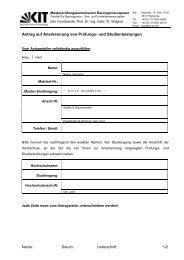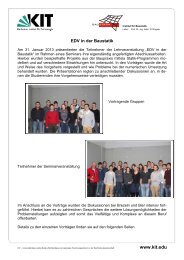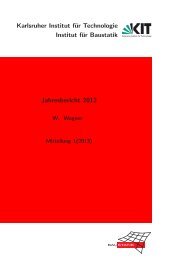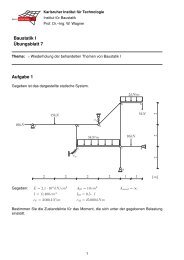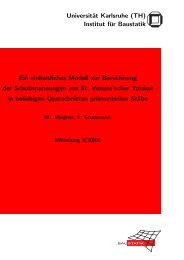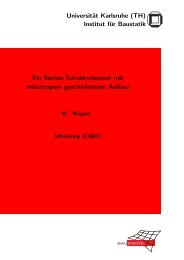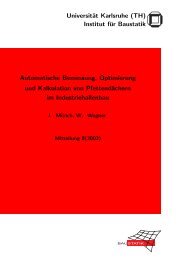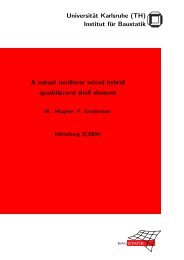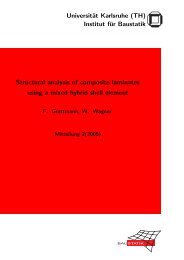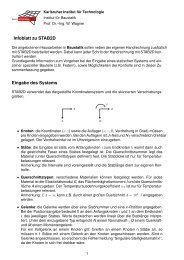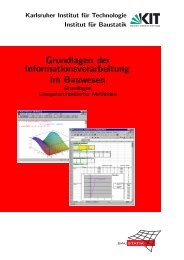Karlsruher Institut für Technologie Institut für Baustatik Adhesive ...
Karlsruher Institut für Technologie Institut für Baustatik Adhesive ...
Karlsruher Institut für Technologie Institut für Baustatik Adhesive ...
- No tags were found...
You also want an ePaper? Increase the reach of your titles
YUMPU automatically turns print PDFs into web optimized ePapers that Google loves.
3.1.1. Shell ElementsThe shell elements used for the simulations are state-of-the-art, so a detailed derivation of the element formulationis not given here. The element type is a quadrilateral iso-parametric plane shell with bi-linear Lagrangian shapefunctions. Geometrical nonlinearity is included by means of Green strains and second Piola-Kirchhoff stresses. Theformulation holds for moderate rotations. Further the normal through-thickness strain and stress are neglected, whichis a reasonable assumption for thin structures. The shell formulation builds upon a Reissner-Mindlin kinematic.Therein, transverse shear is accounted for which usually poses problems related with locking effects. Transverseshear locking is eliminated by the well-known assumed natural strains (ANS) approach [34].The layered formulation incorporates a transversely isotropic material law for each ply where the preferred directionis the fiber direction. An arbitrary stacking sequence can thus be described. The element also allows for anarbitrary choice of the reference surface which is essential for the connection with the interface elements. For theconnection technique the reference surface is the bottom surface for the top sublaminate and vice versa for the bottomsublaminate. Offsets between the reference surface and the mid-surface of a particular ply are accounted for in thethickness integration scheme.3.1.2. Interface ElementsThe interface element formulation has been derived in detail in Refs. [35, 36, 37] and will not be repeated in thispaper. The eight-node elements work in traction-separation relationships. The tractions are the interfacial tractions,which are the normal traction perpendicular to the interface, t I , and the two shear tractions parallel to the interface,t II and t III . The single mode separations are denoted by ū I ,ū II ,andū III . The separations are defined as the relativedisplacements between the top and the bottom sublaminate. Hence, the separations are obtained by simply subtractingthe displacements of the bottom surface from the displacements of the top surface, of which each is approximated bybi-linear Lagrangian shape functions. It should be mentioned that the initial thickness of the interface is equal to zero.A similar element type has been used by several authors, see e.g. [38, 39, 40, 41, 42, 43, 44, 45, 46] among manyothers.3.1.3. Cohesive LawThe cohesive law implemented in the interface element is a modified version of that proposed in [47, 48]. Detailsabout this model can be found in [35, 49, 50, 51]. The model bases on the universal binding law of Rose et al. [52].The original model from [47, 48] is edited in a way that only tensile normal tractions or the shear tractions triggerdamage within the interface, and not interfacial compression. A penalty contact formulation is added in order to avoidthe interpenetration of cracked surfaces.The resulting traction-separation laws for single mode I and II loading conditions are depicted in Fig. 10. Theresponse in single mode III is qualitatively identical to that in mode II. It should be mentioned that for shearing theseparation sign has no influence, whereas in mode I there is the softening behavior for tension and the contact behaviorfor compression. The peaks characterizing damage initiation are governed by the mode I and II strengths, R I and R II ,and the corresponding separations, ū 0 Iand ū 0 II. The points where the tractions revert to zero correspond with totaldecohesion. The areas under the traction-separation curves are defined as the CERRs. The parameter K denotes thepenalty stiffness applied in the event of contact. In contrast to the nonlinear loading path unloading is linear to theorigin as depicted in Fig. 10. This history-dependency avoids healing of the interface.In order to account for mixed mode loading conditions an effective traction and an effective separation are introducedto generate a mode coupling yielding an effective traction-separation law 3 . The area under this effectivetraction-separation law is the mixed mode CERR. It should be mentioned that we assume the same strengths for modeII and III. In [50] the smooth exponential cohesive law has been proven to be superior compared with a classicalbi-linear model, as e.g. described in [53, 54], in terms of computational stability and convergence behavior.3.2. Validation with Co-cured InterfacesIn order to prove the capabilities of the analysis approach, and to motivate the choice of this approach for a numericalestimation of the CERRs in single mode I and mixed mode I/II loading conditions, DCB and MMB delamination3 For single mode loading conditions the effective traction-separation law is equal to the corresponding single mode traction-separation law asdepicted in Fig. 10.13



